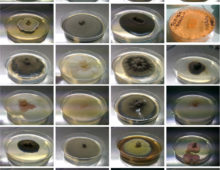Wetlands are the single largest global source of atmospheric methane (CH4), a potent greenhouse gas. Seasonally inundated tropical forests are estimated to be the main contributors of biologenic emissions of this gas. This project aims to integrate microbial and tree genetic characteristics to measure and understand methane emissions at the heart of the Amazon rainforest….
Genomic Diversity in the Saccharum Complex
The proposal calls for sequencing accession (genetically unique plant samples from a particular geographic location) representatives of the Saccharum genus and key sugarcane cultivars to elucidate their genome structure, origin and phylogenetic relationships. This information will help optimize breeding and base-broadening programs and builds off the ongoing sugarcane genome proposal. Proposer: Angelique D’Hont, CIRAD (France)…
Epigenome Regulation of Gene Expression
Plant biomass degradation by fungi is a key step of the carbon cycle on earth, but carbon sequestration is also mediated by mutualistic fungi through symbiosis with plants. Indeed plant material is the most abundant repository of organic carbon and fungi are the primary decomposers of dead or alive plant cell walls. To do so,…
Finishing Genomes to Leverage Additional Information
Genomes of important model and many industrially important fungi are still incomplete. The goals of this project are: (a) to finish and annotate the genomes of ~25 strains; and, (b) to carry out functional analyses by novel CRISPR/Cas9 approaches. The next quantum leap in biology will come by integrating all levels of genome, transcriptome, proteome,…
Insights into Functional Diversity in Neurospora
This proposal investigates the genetic bases of fungal thermophily, biomass-degradation, and fungal-bacterial interactions in Sordariales, an order of biomass-degrading fungi frequently encountered in compost and encompassing one of the few groups of thermophilic fungi. The proposal fits into the DOE mission because it focuses on biological processes of industrial interest, it explores the functional diversity…
Microbial Methane Production in Freshwater Wetlands
Increasing atmospheric concentrations of greenhouse gasses like methane are altering the global climate, causing catastrophic wildfires, storm events, and drought. This proposal targets microbial methane production in freshwater wetland soils, as this production is the largest natural source of methane. Results from this proposal can improve greenhouse gas predictions across the globe. Additionally, this research…
Sphagnum Microbiome Genetic Interactions
The importance of plant-microbiome systems on carbon and nitrogen processes is perhaps most pronounced in Sphagnum moss dominated ecosystems, which occupy 3% of the Earth’s land surface yet store approximately 25% of terrestrial carbon. Much of the nitrogen needed to support Sphagnum comes from a symbiosis with microbes, yet we don’t know how the symbiosis…
Marine Angiosperm Genome Initiative
Seagrasses are the only flowering plants that live in the sea. Understanding the genomic basis for their many unique adaptations is fundamental to successful management, as seagrasses are being lost globally. Seagrasses are among the world’s largest carbon sinks and thus relevant to the DOE missions carbon cycling, biogeochemistry and JGI plant flagship genomics. Translational…
Genome Level Diversity in Brassica rapa
To avoid competing with land use for food crops, biofuel crops are often grown on marginal land. Understanding how to improve soil health and provide enhance stress tolerance traits is essential for improving biofuel production. This study aims to explore the genome level diversity that exists in the important crop model Brassica rapa, a relative…
Roles of Microbial Communities in the Atacama Desert
The hyperarid core of the Atacama Desert (Chile) is one of the driest deserts on Earth. Its soils represent one of the few environment types that yet have barely been investigated at the level of metagenomics. Due to the extremely low content of biomass these Atacama Desert sediments have been claimed to be Mars-like. We…


